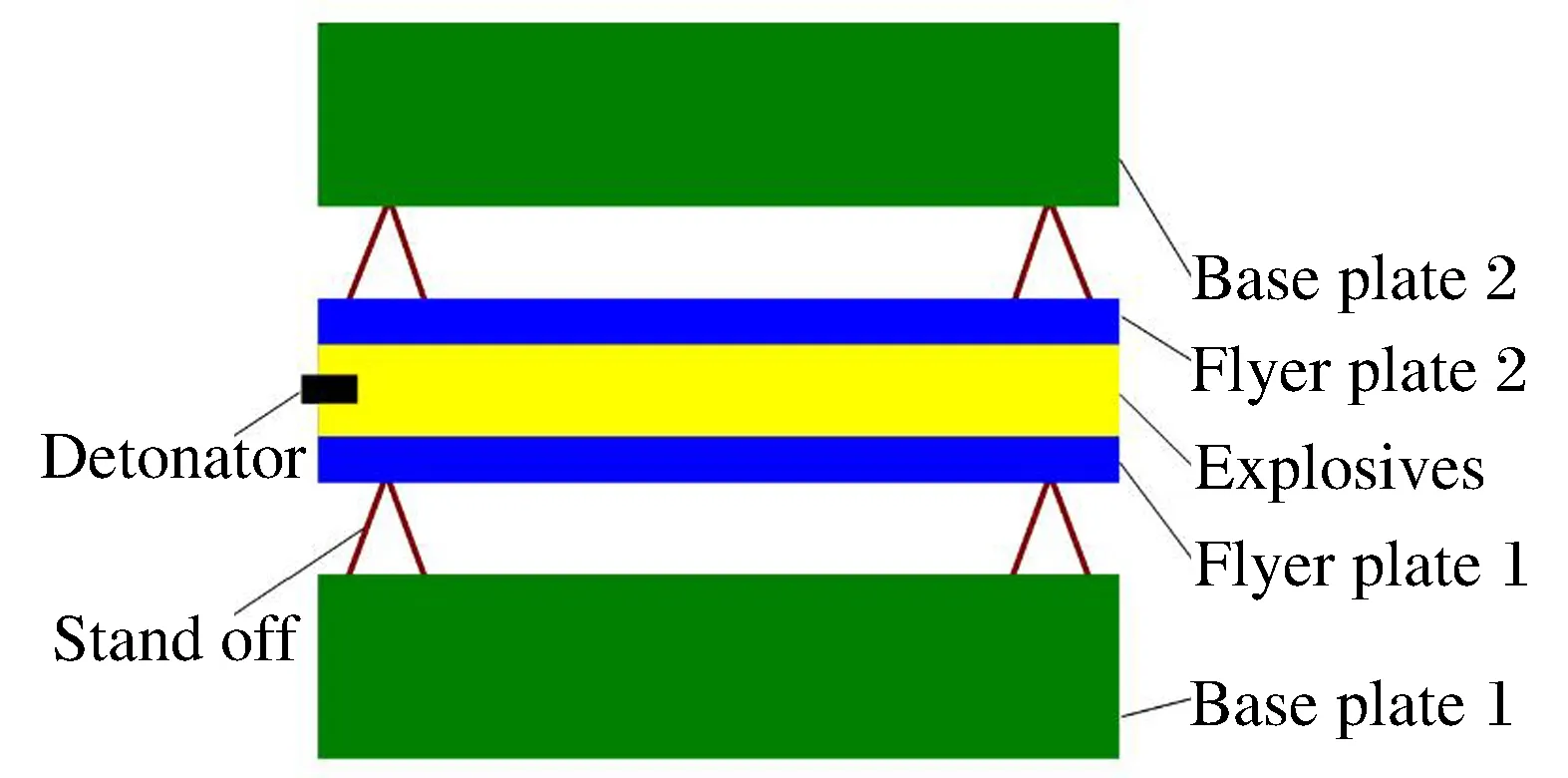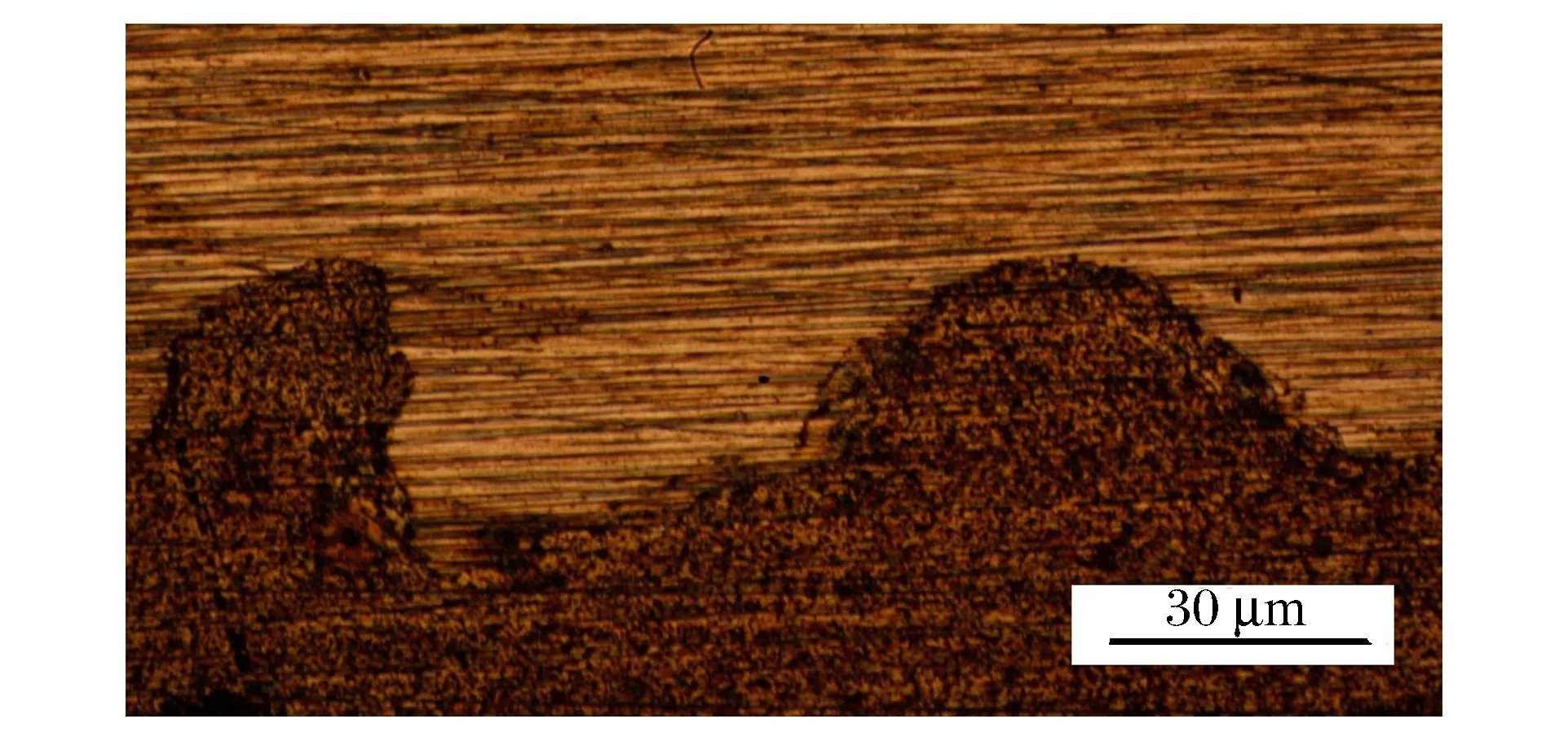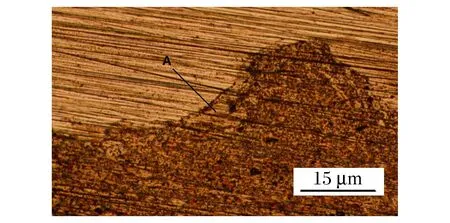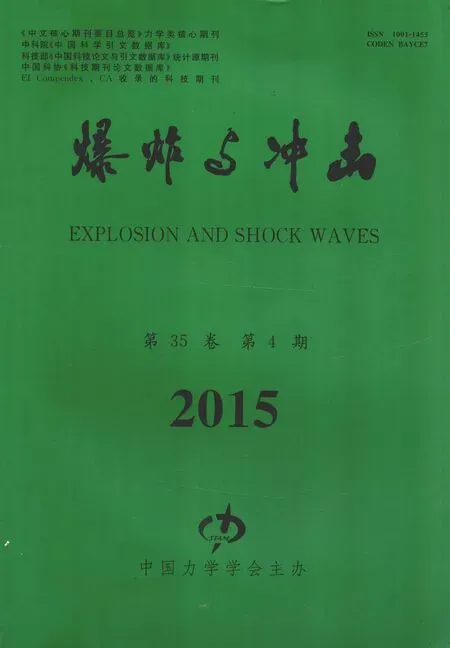不锈钢-普碳钢的双面爆炸复合
缪广红,马宏昊,沈兆武,余 勇
(1.安徽理工大学理学院,安徽 淮南 232001; 2.中国科学技术大学近代力学系,安徽 合肥 230027)
不锈钢-普碳钢的双面爆炸复合
缪广红1,2,马宏昊2,沈兆武2,余 勇2
(1.安徽理工大学理学院,安徽 淮南 232001; 2.中国科学技术大学近代力学系,安徽 合肥 230027)
为了解决现行爆炸复合装药方式落后及炸药爆炸的能量利用率极低的问题,使用了一种保证装药质量的蜂窝结构炸药,并将该蜂窝结构炸药应用于一次起爆可复合二块复合板的双面爆炸复合技术。进行了7 mm厚的蜂窝结构炸药用于3 mm厚的不锈钢板和16 mm厚的Q235钢板的双面爆炸复合实验;并计算得到了复板碰撞速度的上下限及2组实验中复板的碰撞速度。由于受到蜂窝材料和双面复板的多向约束,炸药的临界厚度显著降低,乳化炸药在5 mm厚度时仍可以稳定爆轰。研究结果表明:和现行的单面爆炸复合相比,在复合相同数量复合板的情况下,采用蜂窝结构炸药的双面爆炸复合技术中,炸药的使用量节省了77%,炸药的能量利用率得到显著提高;计算与实验结果一致性较好。
爆炸力学;双面爆炸复合;蜂窝结构炸药;不锈钢;Q235钢;能量利用率
爆炸复合是利用炸药爆炸瞬间产生的大功率能量,使被加工的复板材料产生塑性变形、运动、与基板撞击、熔化并达到原子间结合的一种技术[1]。目前,仅利用炸药一侧能量的单面爆炸复合技术,已经进行了很多深入的计算和研究[2-4]。由于仅利用了炸药一侧的能量,所以大部分能量以冲击波的形式释放在空间,导致能量利用率极低;爆炸产生的噪声,即使在5公里之外仍能达到80~90 db。该技术还存在如下问题:装药方式落后、工作量大,粉尘污染严重、损害操作人员身心健康,厚度和平整程度完全依靠经验、无法保障炸药的密度、均匀性和产品质量。
本文中结合一种保证装药质量的蜂窝结构炸药,在现行平行式裸露装药的爆炸复合结构基础上,在裸露装药上方平行对称的加上一组待复合的复板和基板,采用一次起爆复合二块复合板的双面爆炸复合方法,以不锈钢板和Q235钢板为研究对象进行双面爆炸复合试验,并通过理论计算得到爆炸复合窗口及复板的碰撞速度,预测双面爆炸复合的实验结果。
1 实验材料及参数的计算
1.1 基复板材料
实验选择3 mm厚的304不锈钢作为复板,16 mm厚的Q235普碳钢作为基板。表1中列出了复合材料的力学性能,其中:ρ为密度,σ为极限强度,c为声速。

表1 爆炸复合材料的主要力学性能
1.2 蜂窝结构炸药
本文中选用与黄蜂蜂窝结构类似的蜂窝铝材料,如图1所示。将炸药(本文中所用炸药为含5%玻璃微球的乳化炸药)填充至蜂窝材料的空腔中,形成爆炸复合专用的蜂窝结构炸药,如图2所示。药高由蜂窝材料的厚度直接控制。爆炸复合采用如图3所示的双面爆炸复合方法布置。黄蜂蜂窝结构为自然界中最稳定的结构之一,由于受到结构稳定的蜂窝材料和双面复板的多向约束,炸药的临界厚度显著降低。乳化炸药在无约束情况下,临界直径为14~16 mm[5]。对蜂窝结构炸药在双面爆炸复合中的临界厚度进行测试,得到炸药厚度为3和4 mm时,爆轰可分别传至距起爆端10和17 cm处,在厚度为5 mm时,炸药可稳定爆轰。这节约了炸药量,并拓宽了乳化炸药和其他炸药的应用空间。

图3 双面爆炸复合结构Fig.3 Structure of double sided explosive cladding
利用滑移爆轰下复板的一维格尼(Gurney)公式[6]计算复板的碰撞速度:
(1)
式中:vd为两侧被抛掷金属板的速度,r1、r2为单位面积炸药的质量和复板的质量比,e0为格尼能。
单面复合爆炸中,r2=0,复板碰撞速度计算公式为:
(2)
式中:vs为复板获得的速度,r单位面积上炸药与复板的质量比。
双面爆炸复合中,上下侧的复板完全相同,则质量比r1=r2=r,因此:
(3)
在工艺参数相同的情况下:
(4)
取r=0.37,则有vd/vs=1.59。这说明,在工艺参数相同的情况下,双面爆炸复合的碰撞速度是单面爆炸焊接的1.59倍,为达到相同的碰撞速度,双面爆炸复合的炸药量更少。
1.3 双面爆炸复合窗口的理论计算
由爆炸复合理论可知,爆炸复合参数主要有3个:复板碰撞速度、动态碰撞角、爆速。而这3个参数之间又满足一定的几何关系。因此,3个变量中只有2个变量是独立的。下面以复板的碰撞速度和炸药爆速为设计参量进行相应的计算。
(1) 最小复板碰撞速度的计算。
采用等效正碰撞激波模型,最小复板碰撞速度计算公式为[7]:
(5)
式中:cf为复板中的声速;ρf为复板材料的密度;pmin为实现复合所需的最小冲击压力,对于不锈钢Q235的复合,可取pmin=4.5 GPa。结合式(5)和表1计算可得vmin=197 m/s。
(2) 最大复板碰撞速度的计算。
采用H.K.Wylie等[8]提出的最大复板碰撞速度计算公式:
(6)
式中:df为复板厚度;e为材料在可焊条件下,复板单位面积所具有的最大能量。对于不锈钢/钢的复合,取e=7.54 MJ/m2,实验中复板厚度为3 mm,由(6)式计算vmax=798 m/s。
(3) 炸药爆速的选择。
碰撞射流形成的理论驻点压力须远大于材料强度,使材料表面达到流动状态,顺利形成金属射流。这一限制规定了平行复合时的碰撞点移动速度vp须达到最小值vp,min,该最小值称为流动限。Ezra等认为碰撞点压力应大于材料静强度的10~12倍,爆炸复合的碰撞才进入流动状态[9],即:
(7)
式中:系数a的取值范围为4.47 声速限限制了射流形成过程中的能量。当碰撞点移动速度vp大于材料的体积声速时,射流就不可能产生。所以为了保证形成射流,vp一般不应大于材料声速的1.2倍,最好是小于材料声速。声速限的计算公式为[9]: (8) 式中:cmin为材料体积声速;当材料不同时,取组合材料中体积声速的最小值。在平行法爆炸复合中,碰撞点移动速度等于炸药的爆速,所以炸药爆速的应低于钢中的声速,即vD,max=5 200 m/s。 实验中选择3 mm厚的不锈钢板为复板,16 mm厚的Q235钢为基板,所用炸药爆速为4 900 m/s,双面爆炸复合装置深埋于砂土中,实验共分2组。表2列出了2组实验的参数,其中:h为间隙;d为炸药厚度;l1f、l2f、l3f分别为复板3个方向上的尺寸;l1b、l2b、l3b分别为基板3个方向上的尺寸。 表2 爆炸复合材料的主要力学性能 利用(3)式对双面复合结果进行预测。由于没有乳化炸药的格尼能e0数据,利用e0≈0.6Qv计算该参数[10],Qv为炸药爆热。乳化基质组分的相关数据列于表3,其中w为质量分数,利用文献[11]的计算方法,得到乳化炸药的爆热为2 966.84 kJ/kg。利用所得到的爆热和表2中的质量比,计算得到二组复板的碰撞速度:v1=898 m/s,v2=787 m/s。 表3 乳化基质的组分 由2组复板的碰撞速度可以看出,仅第2组复板的碰撞速度落在爆炸复合窗口内。按照表2中的工艺参数进行爆炸复合实验。由于爆炸复合装置深埋在砂土中,炸药两侧的基复板所受到的约束情况一致,爆炸复合质量相对也是一致的,所以任取2块复合板中的一块取样做金相分析即可,图4和图5为第2组复合板经线切割所取试样的金相图。 图4 第2组爆炸复合板界面波形Fig.4 Interface wave of sample experiment 2 图5 第2组爆炸复合板界面单个波形Fig.5 Single interface wave of sample experiment 2 第1组实验中,由一维格尼公式计算得到的复板碰撞速度为898 m/s,超过了可焊窗口的最大极限速度798 m/s,碰撞速度过高。实验结果为2块复板均与2块基板分离,分析原因:由于碰撞速度已超过爆炸复合上限,对应的爆炸复合能量也就过大,复合界面沉积的热量过高,爆炸复合结束后界面仍处于热软化状态,反射的稀疏波就会拉开复合界面,造成爆炸复合失效,即造成复板与基板的分离。 第2组实验中,由一维格尼公式计算得到的复板碰撞速度为787 m/s,未超过可焊窗口的最大极限速度798 m/s,因此结合质量较好。图4所示结合界面为波长为95~120 μm、波高为25~35 μm连续的波状结合界面。图5是放大的单个波形图,图中A所指的波前涡与其他区域颜色不同,为极薄的熔化层,说明结合界面熔化量较小。一般认为爆炸复合具有3种形式的波状界面[12]:微波、小波、大波,这里所得到的不锈钢/Q235钢结合界面与微波状界面尺寸(波长一般在100 μm左右,波高在20 μm左右)基本一致。微波状结合和大(小)波状结合相比,几乎没有过渡区域、没有缝隙和疏松状的“空洞物”等缺陷,因此微波状结合的第2组爆炸复合具有较高的结合强度。 由第2组实验可以看出,本文中所使用的高爆速炸药,可以满足爆炸复合的要求,爆炸复合产生了结合强度较高的微波状的结合界面。与传统的爆炸复合所用的低爆速炸药相比,爆速越高所对应的爆轰压力和爆炸产物的能量也就越高,提供给复板的加速度就越大,为使复板达到与使用的低爆速炸药产生相同的碰撞速度,所用的炸药量相对也就越少。 乳化炸药在无约束的情况下,临界直径为14~16 mm,因此用于现行的单面爆炸复合时,炸药厚度应至少为14~16 mm,且一次起爆仅得到一块复合板。该7 mm厚的蜂窝结构炸药用于双面爆炸复合时,一次起爆可复合2块复合板,在复合相同数量复合板的情况下,炸药使用量减少了77%。 (1) 双面爆炸复合方法中两复板和蜂窝铝的多向约束,可以有效的降低炸药稳定爆轰的临界直径,乳化炸药在厚度为5 mm时,仍能稳定爆轰;双面爆炸复合使炸药爆炸产生的能量绝大部分用于材料的复合,对于不锈钢/钢的复合炸药量节省了77%,以冲击波的形式释放在空间的能量明显降低,爆炸产生的噪音得到控制,炸药爆炸的能量利用率更高,节能减排有利于环境保护。 (2) 实验中选用的是高爆速炸药,爆速越高,对应的爆轰压力和爆炸产物的能量越高,提供给复板的加速度也就越大,复板达到与使用的低爆速炸药产生相同的碰撞速度时所用的炸药量也就相对越少。 (3) 针对不锈钢/Q235钢进行的双面爆炸复合实验,爆炸复合界面的结合形态中均匀细小的微波状结合,其波长为95~120 μm、波高为25~35 μm,由于缝隙较小、空洞较少具有较高的结合强度,结果表明双面爆炸复合切实可行。 (4) 所采用的爆炸复合参数计算准确的描绘了不锈钢/Q235钢的可悍性窗口,并通过一维格尼公式计算了复板的碰撞速度,不锈钢/Q235钢的爆炸复合实验表明,计算能较好的预测实验结果。 [1] 郑远谋.爆炸焊接和爆炸复合材料的原理及应用[M].长沙:中南大学出版社,2007:18-20. [2] Wang X, Zheng Y Y, Liu H X, et al. Numerical study of the mechanism of explosive/impact welding using smoothed particle hydrodynamics method[J]. Materials and Design, 2012,35:210-219. [3] Chen S Y, Wu Z W, Liu K X, et al. Atomic diffusion behavior in Cu-Al explosive welding process[J]. Journal of Applied Physics, 2013,113(4):044901. [4] 孙宇新,康宗维,付艳恕,等.多层金属板爆炸焊接研究[J].南京理工大学学报,2009,33(5):596-599. Sun Yu-xin, Kang Zong-wei, Fu Yan-shu, et al. Explosive welding of multilayer metal plates[J]. Journal of Nanjing University of Science and Technology, 2009,33(5):596-599. [5] 宋锦泉.乳化炸药爆轰特性研究[D].北京:北京科技大学,2000:45-47. [6] Cooper P W. Explosives engineering[M]. New York: Wiley-VCH, 1997:15-35. [7] Blazynski T Z. Explosive welding forming and compaction[M]. London: Application Science Publishers Ltd, 1983:45-50. [8] Wylie H K, Williams P E G. Further experimental investigation of explosive welding parameters [C]∥Proceedings of the 3rd International Conference of the Center for HEF. Denver, CO, USA: University of Denver, 1971:1-43. [9] 邵丙璜,张凯.爆炸焊接原理及其工程应用[M].大连:大连理工大学出版社,1987:8-287. [10] Kennedy J E, Zukas J A, Walters W P. The Gurney model of explosive output for driving metal explosive effects and applications[M]. New York: Springer, 1998:221-257. [11] 陆明,吕春绪.乳化炸药配方设计的数学模型研究[J].爆炸与冲击,2002,22(4):338-342. Lu M, Lu C X. The mathematical model for the formulation design of emulsion explosive[J]. Explosion and Shock Waves, 2002,22(4):338-342. [12] 王耀华.金属板材爆炸焊接研究与实践[M].北京:国防工业出版社,2007:31-38. (责任编辑 王小飞) Double sided explosive cladding of stainless steel and ordinary carbon steel Miao Guang-hong1,2, Ma Hong-hao2, Shen Zhao-wu2, Yu Yong2 (1.SchoolofScience,AnhuiUniversityofScienceandTechnology,Huainan232001,Anhui,China; 2.DepartmentofModernMechanics,UniversityofScienceandTechnologyofChina,Hefei230027,Anhui,China) In order to resolve the current issue about the backward method of charge and low energy efficiency of explosives, a kind of explosive with the structure of honeycomb is used to ensure the quality of the charge and is applied in double sided explosive cladding in which two plates can be combined in one explosion. A double sided explosive caldding experiment of stainless steel plates with the thickness of 3 mm and Q235 steel plates with thickness of 16 mm is carried out by using the explosive with the thickness of 7 mm. The explosive cladding window of the collision velocity is calculated as well as the collision velocity in two groups of the tests. The critical thichness of the explosive is remarkbly reduced with the explosive astricted by the honeycomb structure and the plates. The emulsion explosive with the thickness of 5 mm detonates stably. The result shows that, compared to the existing explosive cladding method, the consumption of explosives by using this method is reduced by 77% in the case of cladding the same number of combination plates. The calculation prefigure explosive cladding of stainless steel/Q235 steel exactly. mechanics of explosion; double sided explosive cladding; explosives with structure of honeycomb; stainless steel; Q235 steel; energy efficiency 10.11883/1001-1455(2015)04-0536-05 2013-12-11; 2014-04-03 国家自然科学基金项目(51374189,51174183) 缪广红(1985- ),男,博士研究生; 通讯作者: 马宏昊,hhma@ustc.edu.cn。 O389 国标学科代码: 13035 A2 双面爆炸复合实验




3 结 论

